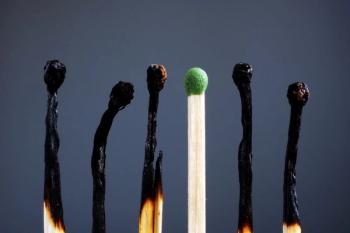
How Does Psychiatry Interface With Creativity?
Discover how psychiatry and creativity intertwine, exploring the link between mental health and artistic expression.
Consider that 1 of the best antidotes for career burnout is creativity, or at least allowing for its possibility. Burnout, an insidious condition, is often associated with shame and is apt to be denied. Health care providers typically trudge on even when experiencing 1, 2, or all 3 of the classically formulated burnout characteristics: emotional exhaustion, a sense of detachment, and lack of enthusiasm for one’s own achievements (the no big deal syndrome). After all, who likes to admit that they are burned out, especially clinicians who are so success driven?
Health care entities are undoubtedly mindful of the burnout potential amongst their doctors, and not to oversimplify the multi-faceted nature of health care delivery, medical institutions must also prioritize sufficient patient volume and levels of service to ensure long term viability. That said, when providers are continually working in acute, fast paced environments, the imaginative, free-floating zone can be displaced in lieu of meeting job responsibilities and care management essentials.
Creativity is commonly defined as imagining and implementing that which is novel. A key component of creativity is inventiveness, preparing something new from something else or even from nothing. Creativity in the service of making the world a better place involves originality, transformation, and savvy management.
I recently had a conversation with Professor Robert Butts, conductor and music educator, regarding his thoughts on creativity. Butts supports the belief that creativity is highly complex, almost a mystery, meaning different things to different individuals. Inspired by the vastness of the ocean and mountains while vacationing on a scenic cruise in Alaska, Butts composed a 4 movement string quartet. Vacation for the professor appears to have included opening up creative mind space in order to compose music.
A review of all the great thought leaders’ viewpoints on the subject of creativity would be beyond the span of the current discussion. However, I can certainly think of several who stand out. Sigmund Freud, for instance, originally published On Creativity and the Unconscious in 1925. Although he conceptualized humor as having its roots in sexuality and or aggressiveness, for Freud, humor ultimately passed the test as protecting the ego. I have always come to regard a sense of humor as a higher level of defense. When introduced empathically in a fitting circumstance to the correct patient, a bit of levity can strengthen the doctor-patient relationship.1
Edward De Bono, MD, PhD, described 4 types of thought: natural, logical, mathematical, and lateral. It was lateral thinking that De Bono viewed as flexible, fluid, nonlinear, and non rule- bound. Lateral thought provided the conduit through which creativity could flow.2 In everyday terms, we often refer to lateral thinking as thinking outside of the box. Examples of lateral thinking would be the writer who reports their best ideas emerge when away from the screen and out walking, or the tennis pro recuperating in the sauna and mapping out their next tournament strategy.
In The Art of Possibility, coauthors Rosamund Stone Zander and Benjamin Zander echo the sentiment of De Bono. Free floating and creative thought requires the establishment of context. The authors maintain that “in the universe of possibility, you set the context and let life unfold.” To be creative, there must be a transition away from the limitations of the world of measurement and onto the world of possibility.3 That is astonishingly beautiful to contemplate!
People are often intimidated by the subject of creativity—understandable given its complexity. They might opt to remain on safe and familiar footing even if that potentially breeds tedium, inferred as a risk factor for burnout. They may have come to believe that they themselves are not particularly creative, and that to be creative, they would have to emulate an established painter or play the piano like the late Duke Ellington. They may believe that they have to develop some sweeping AI business innovation that becomes a game changer. So, yes, from that perspective creativity can be a daunting prospect!
The fact is that most of us have access to creativity right at our fingertips. We do not necessarily have to opt out of our daily routine to maintain creativity. Instead, we can choose to opt in. For instance, reverting to the topic of humor, if we hear a funny story or joke and decide to share it using our own embellishments, that is being creative and having a positive impact on others through inventive use of conversation. Moreover, individuals who simultaneously manage careers and caretaking responsibility, be it for children, family members, or pets, are some of the most creative time managers around.
In my psychiatry training, creativity was never formally taught as a course, but it was certainly understood as a vital and pervasive clinical underpinning. The accompanying table outlines in the broadest of strokes how we as healthcare providers utilize everyday creativity in our decisions without necessarily conceptualizing it as such.
In conclusion, while creativity can certainly suggest A huge impact on projects such as AI, currently still in its evolution, there is something to be said for the ever-replenishing role of creativity in everyday life, especially as we enter the new year.
Dr Sofair is a practicing psychiatrist affiliated with CarePoint Health.
Acknowledgement: Special thanks to Professor Robert Butts for generously sharing his views on the subject of creativity.
References
1. Gibson N, Tantam D. The best medicine? The nature of humour and its significance for the process of psychotherapy. Existential Analysis. 2017;28(2):272-287.
2. De Bono E. The Mechanism of Mind. Penguin Books; 1969.
3. Zander RS, Zander B. The Art of Possibility. Penguin Books; 2002.
Newsletter
Receive trusted psychiatric news, expert analysis, and clinical insights — subscribe today to support your practice and your patients.














